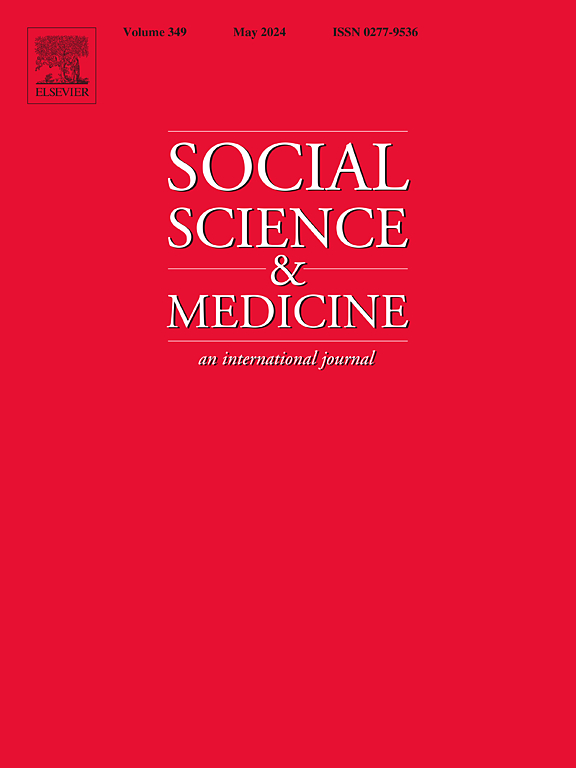从补贴到营养:调查尼日利亚补贴再投资计划对同组儿童的影响。
IF 4.9
2区 医学
Q1 PUBLIC, ENVIRONMENTAL & OCCUPATIONAL HEALTH
引用次数: 0
摘要
本研究调查了一项针对需求方和供应方因素的全国性孕产妇保健计划对母亲可能参与该计划的五岁以下儿童营养状况的影响。我们采用了 "差异中的差异 "方法,将计划受益机构与家庭居住的地区和社区进行匹配。数据来自尼日利亚 2008 年、2013 年和 2018 年的人口与健康调查(DHS),包括约 12 万名儿童的回答。我们的研究结果表明,儿童饮食多样性明显增加,尤其是在有两个受益设施的地区,这表明随着计划的扩大实施,效果会更明显。此外,我们还观察到,在有两个受益设施的地区,儿童对各种营养食品的消费产生了积极影响。本研究调查了通过资助每个地区两家诊所来扩大医疗保健设施覆盖面的潜在机制,该机制可能有助于改善儿童的饮食多样性。我们的研究结果表明,与只有一家受益机构的地区不同,那些拥有两家受资助诊所的地区,妇女从事家庭以外的工作并从中赚取现金的可能性更高。如分析所示,这种机制可能是由于更容易使用医疗设施以及与卫生官员有更好的接触,这有助于母亲在分娩后更快地重返劳动力市场,进而提高母亲的收入,并有可能使儿童的饮食更加多样化。研究结果表明,SURE-P 的广泛实施加强了儿童营养成果,并有助于增强孕产妇的经济能力。在拥有多个 SURE-P 设施的地区,医疗保健服务的增加使母亲能够更快地重返劳动力市场,促进现金收入,并促进儿童饮食多样性的改善和家庭经济收益的强化循环。这凸显了在类似情况下推广此类计划以最大限度地提高健康和经济成果的潜力。本文章由计算机程序翻译,如有差异,请以英文原文为准。
From subsidies to nutrition: Investigating effects among cohort children from the Subsidy Reinvestment programme in Nigeria
This study investigates the effect of a nationwide maternal health programme that targets both demand- and supply-side factors on the nutritional status of children under five years old whose mothers were potentially exposed to the programme. We employed a difference-in-differences approach by matching programme beneficiary facilities to the districts and communities where households reside. The data are drawn from the 2008, 2013, and 2018 rounds of Nigeria's Demographic and Health Surveys (DHS), comprising responses for approximately 120,000 children. Our findings reveal a significant increase in child dietary diversity, particularly in districts with two beneficiary facilities, suggesting stronger effects with expansive programme implementation. Additionally, we observed positive effects on children's consumption of various nutritious foods for those children in districts with two beneficiary facilities. This study investigates a potential mechanism by which expanding access to healthcare facilities, through funding two clinics per district, may contribute to improved child dietary diversity. Our findings suggest that, unlike districts with one beneficiary facility, those with two funded clinics have a higher likelihood of women engaging in work outside the home and earning cash for it. As shown in the analysis, this mechanism is likely due to easier access to health facilities and better contact with health officers, which facilitate quicker reintegration into the labour market for mothers after childbirth and, in turn, could lead to better maternal earnings and potentially enable a more diverse diet for children. The findings suggest that SURE-P's expansive implementation strengthens child nutrition outcomes and supports maternal economic empowerment. In areas with multiple SURE-P facilities, increased access to healthcare enables mothers to reintegrate into the labor market more quickly, facilitating cash income and fostering a reinforcing cycle of improved child dietary diversity and economic benefits for families. This highlights the potential of scaling such programs to maximize both health and economic outcomes in similar contexts.
求助全文
通过发布文献求助,成功后即可免费获取论文全文。
去求助
来源期刊

Social Science & Medicine
PUBLIC, ENVIRONMENTAL & OCCUPATIONAL HEALTH-
CiteScore
9.10
自引率
5.60%
发文量
762
审稿时长
38 days
期刊介绍:
Social Science & Medicine provides an international and interdisciplinary forum for the dissemination of social science research on health. We publish original research articles (both empirical and theoretical), reviews, position papers and commentaries on health issues, to inform current research, policy and practice in all areas of common interest to social scientists, health practitioners, and policy makers. The journal publishes material relevant to any aspect of health from a wide range of social science disciplines (anthropology, economics, epidemiology, geography, policy, psychology, and sociology), and material relevant to the social sciences from any of the professions concerned with physical and mental health, health care, clinical practice, and health policy and organization. We encourage material which is of general interest to an international readership.
 求助内容:
求助内容: 应助结果提醒方式:
应助结果提醒方式:


